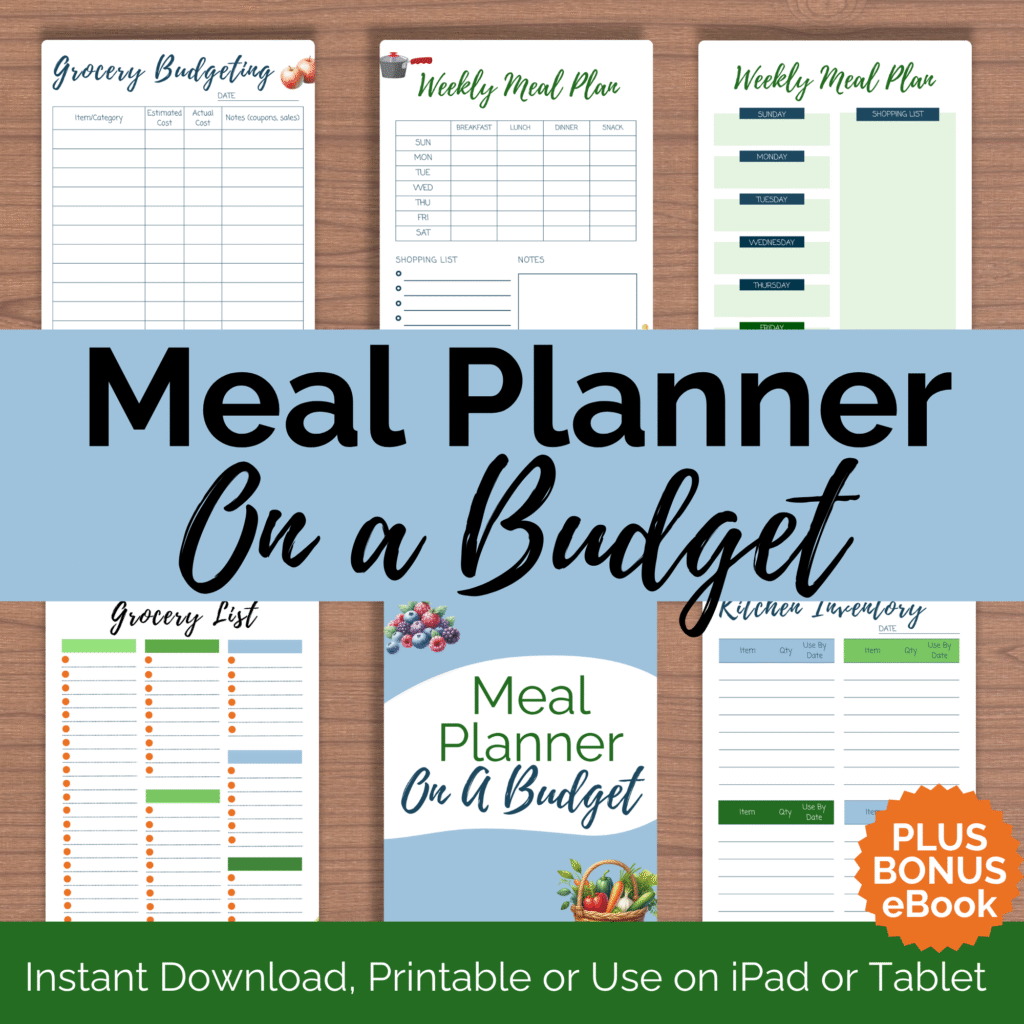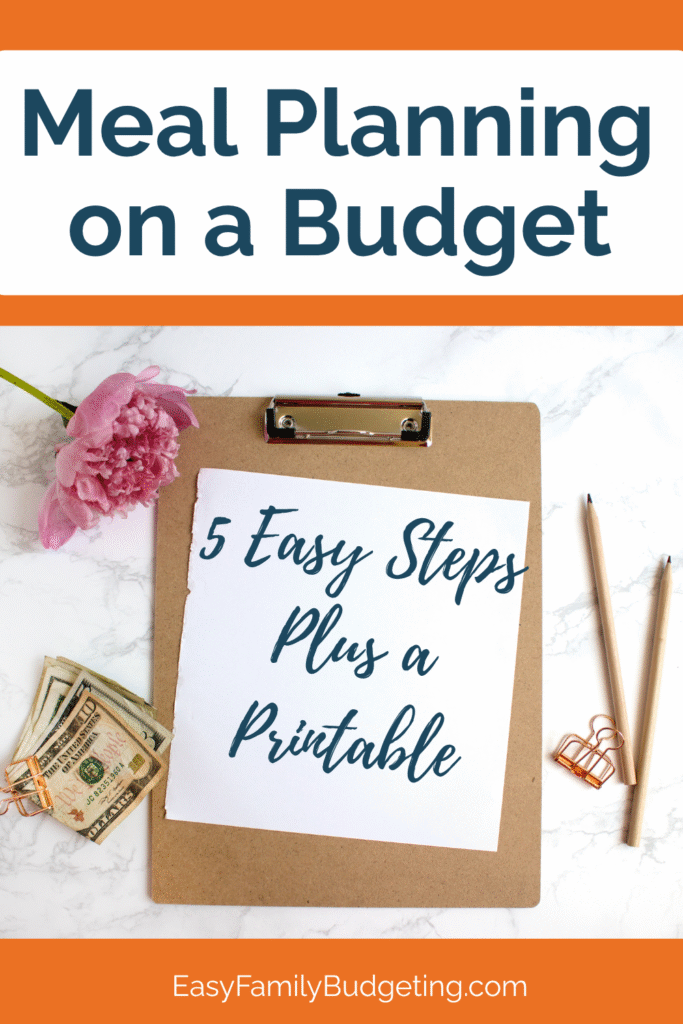Groceries are expensive! Within this blog post I’ll show you how to create a budget friendly meal plan that will help you stick to your food budget and reduce food waste. It’s easier than you think!
Meal Planning on a Budget
Groceries just keep getting more expensive these days. Instead of worrying about your increasing grocery bill and feeling like you have no control over it, you can take control by meal planning to help keep costs down. You don’t have to plan for everything, we tend to use meal planning for dinner and then we have staples that we buy for the other meals. You surely can plan for all of them though!
Meal planning seems daunting at first, I completely understand. I have some resources for you that I suggest you try out if you don’t want to start from scratch.
This is great for anyone, especially families, those with food sensitivities or food allergies, students, people on a fixed income, really anyone who wants to lower their grocery costs.
Steps To Create a Budget-Friendly Meal Plan
1. Set a Weekly or Monthly Food Budget
Depending on your financial situation and how you budget your money, you can set a weekly or a monthly meal plan.
If money is tight and you live paycheck-to-paycheck, plan for one or two weeks, depending on how often you get paid.
If you aren’t struggling as much financially, you can set a monthly food budget and check in throughout the month to ensure you’re sticking to it.
You can always switch from monthly to weekly and back again as you need to. One huge thing I stress about the way I teach budgeting is to do what works for you. Don’t try to fit yourself into someone else’s plan, find what works for you, your family, and your financial situation.
According to some sources, you should allocate 10-15% of your income to groceries.
- Look back at what you’ve spent in the past few months on groceries so you have an idea of what you’ve spent in the past. I always suggest looking back before looking forward so you have a jumping off point, so to speak. Otherwise, you’re going to have a much harder time not knowing your numbers.
- Based on what you have spent on groceries in the past month or so, come up with an average that you spend.
- I’m guessing you want that number to be less than it has been so keep that number in mind and follow the remaining steps
2. Check What You Already Have
Look in your pantry, fridge, and freezer to see what you already have. I suggest taking an inventory of meal staples that you already have. These can include black beans, soy sauce, tomato sauce, noodles, chicken stock, brown rice, and other pantry staples. Personally, I don’t include snacks such as chips and cookies, but you can if you’d like.
In the fridge, write down what you have, especially perishable food that need to be used soon before they expire.
You may be surprised by how much is in our freezer, especially if you have a chest freezer like we do. Be sure to write down everything that is frozen including ground beef, chicken, frozen vegetables, frozen chicken thighs, ground turkey, frozen pizzas, and more.
Helpful Tips:
- Keep track of all the meal staples that come into the house if they aren’t planned so you always know what you have on hand to use for meal planning.
- Keep this list in a digital app such as Google Keep and share it with your significant other so they can add things as well!
Note: Later I’ll share that I suggest ONLY buying what you have on your grocery list from your meal plan BUT there is an exception for if you find things on sale that you know you’ll use in the future. Then I’m all for stocking up but keeping track of them with your new system.
3. Meal Plan With What You Have First
Keep in mind what you already have on hand from step 2. Have these lists nearby while you meal plan. Make a note within your meal plan of when you need to thaw any frozen foods. For example, when we have hamburgers on our meal plan, I make a note (and set a reminder on my phone) for two nights prior to the meal to thaw the ground beef so it’s ready for me the day I need it.
The great thing about creating a meal plan based on what you have first is you’ll have a pretty low grocery bill that first week or so while you work through what you forgot you had!
For easy recipes using what you have, you can utilize a slow cooker to cook your meats and veggies all in one for a delicious meal for the whole family!
4. Meal Planning Beyond What You Have
Now that you’ve planned part of your week or whatever amount of time works for you, with what you already have, you can start planning the rest of your meals.
Consider:
- What’s on sale right now at your local grocery stores such as in their weekly ad
- Seasonal produce, it’ll likely be cheaper
- What’s available at the local Farmer’s Market if you have one, also based on season
Simple, budget-friendly meals can include rice bowls, pasta dishes, soups, and slow cooker meals. Keep the possibility of leftovers in mind while you’re building your weekly meal plan. We used to have a lot more leftovers when our twins were little but now that our family of five all eat a substantial amount, we don’t have leftovers as often unless we make a double batch of a meal.
5. Only Buy What You Planned
The huge key of this is to ONLY buy what you have planned in your meal plan. I meal plan on Wednesdays for the following week and get groceries on Fridays for that following week. You do what works for you.
In terms of perishables, when you buy them, make sure they won’t expire before you are going to use them. If they are going to expire before then you can either adjust your meal plan OR freeze the item until a day or two before you’re going to use it, if it’s something like ground beef, chicken, or ground turkey that can be frozen.
Like I mentioned earlier, things such as breakfast items, lunchmeat and bread for sandwiches for lunch, and other items can be meal planned or just always have them on hand.
We do a mix of the two. We do have a plan for breakfasts because it’s just easier that way to keep some variety and know what to expect. Who wants to have the “what’s for breakfast?” question before they even have their first sip of coffee? I know I don’t!
My kids are always home with me during the day since they do online school so I make their lunches at lunch time and have flexibility in what I make since we’re at home. That may be different if your child goes to school in person like most do. Plan for different days of what they’d like to eat.
As I mentioned above, an exception to only buying what you planned is if there is a good sale on something that you will actually use. Such as, BOGO 50% ground beef, if you know you’re going to use it then buy one for this week for your meal plan and freeze the other pound, ensuring you keep track of what you froze so you can use it later.
Saving Money on Groceries
While meal planning will help you save money by only buying what’s on your list or what’s on sale that you know you’ll use in the future, as well as reducing food waste, there are other things you can do to help save money at the grocery store. I have a whole blog post about saving money at the grocery store if you want to go more in depth but here are some highlights:
- Use cash back apps such as Rakuten, Ibotta, and Merryfield
- Opt for frozen foods including: frozen vegetables, frozen meat, and frozen fruits as they’re typically less expensive than fresh and just as healthy.
- Try new recipes with cheaper ingredients such as black beans, sweet potatoes, pasta sauce, hot dogs, corn tortillas, cooked pasta, ground beef, ground turkey, etc.
- Buy in bulk if you can especially when things are on sale that you are sure you’ll use AND you have room for. Don’t buy a whole bunch of ground beef on sale if you can’t fit it in your freezer, it’ll just go to waste.
- Subscribe and Save for items that you get online, especially specialty items including gluten-free foods that you need on a regular basis.
- Comparison shop between local stores and online. I’ve started that here: Grocery Price Comparison
Tools To Help You
Now that you know what to do, you could use some tools to help you accomplish all of this! I have a few things to help you out.
First, I have a free printable that you can just enter your email address below and get the template I use for meal planning per week as well as a grocery list.
Second, if you’d like a bit more help, I have a Meal Planning on a Budget printable that you can purchase on my Etsy shop where you can also have pages for writing down what you already have including pages for kitchen, pantry, fridge, freezer, and storage inventory as well as recipe cards, lists for favorite foods, recipes, recipes to try, and of course, four different meal planning variations that you can choose from!

Pin to Pinterest!

Throughout my parenting journey with 3 kids on a single income, I have become an expert in living comfortably within our means without feeling restricted and I will help you do the same.
I'm a former school psychologist who left my career to stay home with my children, hence the one-income family and needing to adapt to that mentality while still living comfortably.

